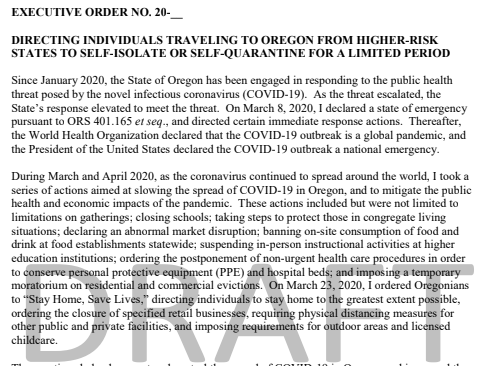
News got out in Oregon in August that Gov. Kate Brown was considering travel restrictions. On Aug. 4, the Governor’s Office told legislators that it was considering a travel ban, according to an email obtained by Eugene Weekly. That same day, a spokesperson for the Governor’s Office told EW the focus on travel restrictions was related to tourist travel from hotspot states and communities.
EW filed a public records request and obtained emails between the Oregon Governor’s Office and nearby states that show an early draft of a 14-day quarantine executive order modeled after New York and New Mexico, as well as communication with California’s governor’s office, which seemed hesitant to implement such restrictions.
As of press time, the Oregon Governor’s Office had not replied to EW’s questions, though the office was dealing with the state’s sudden wildfire crisis.
On Thursday, July 23, chief of staff for New Mexico’s Gov. Michelle Lujan Grisham, John Bingaman, told Oregon’s Governor’s Office that they had implemented travel restrictions enforced at airport arrivals and expanded it to all vehicle travel. Because it decreased tourist travel, it was a blow to the industry, Bingaman wrote in the email.
A few hours later, Brown’s Chief of Staff Nik Blosser emailed California and Washington state officials that the office nearly had a complete draft proposal that was a combination of New Mexico and New York’s policies.
At 3:32 pm, Blosser emailed officials at governor’s offices in the Western U.S. states a draft of the executive order for them to discuss. In the email, he said Travel Oregon, Oregon’s ports and parks and transportation departments had seen it “briefly” and had no substantive comments.
In a separate email to Idaho’s chief of staff sent July 23, Blosser said the main questions around the travel restrictions were enforcement and working as a region. Blosser added that the timeline was to announce the restrictions by the end of the next week, which would have been around July 31.
According to an early draft of the executive order, non-residents and residents who travel to Oregon from hotspot states would have to undergo two weeks of quarantine. The draft defines what a hotspot state is based on cases per 10,000 cases, positivity percentage rates or whatever Oregon Health Authority decided. There were exemptions, such as for people traveling to and from a workplace, for job-related or business activities; for basic needs like shelter, health care and food; essential services; or for necessary care for family or elderly people.
The executive order draft said the people who did not comply would be subject to involuntary isolation and quarantine orders.
On July 27, California Gov. Gavin Newsom’s chief of staff, Ann O’Leary, sent an email to Blosser and other governors’ chiefs of staff. O’Leary said Newsom was interested in a Western States Pact on “safe travel” since he had not seen evidence in California that COVID spreads through tourism. The West Coast states, Nevada and Colorado formed a Western States Pact earlier this year as a way to coordinate responses to COVID.
O’Leary suggested guidelines like wearing a mask during air travel, travel as a household and don’t visit relatives, friends or groups outside the household. The proposed agreement would also include an agreement to share recent travel history of COVID positive travelers when necessary, as well as press the Federal Aviation Agency and airlines to require masks and install mass fever screenings at major airport security gates.
Three days later, O’Leary emailed Blosser again, asking whether Oregon would pursue the travel quarantine or if the states could collaborate on a safe travel pact. Blosser replied that no decision had been made and staff still needed to brief Brown on the executive order.
Brown hasn’t made any decisions on travel restrictions other than they might be a consequence should Oregonians not lower COVID numbers by wearing masks and practicing social distance measures, as she said at an Aug. 21 press conference.
Had Oregon enacted the 14-day quarantine, it would have joined 20 other states that have recommended or required self-quarantine. According to Lane County data, travel-related cases are the largest causes of COVID-19: 42 percent of COVID-19 cases are from international and domestic travel.
Read the full Draft of Executive Order on Quarantine Restrictions